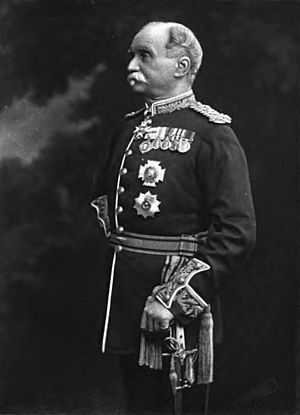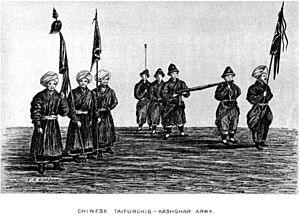Thomas Edward Gordon facts for kids
Quick facts for kids
Sir
Thomas Edward Gordon
|
|
|---|---|

Gen. T. E. Gordon, 1906
|
|
| Born | 12 January 1832 |
| Died | 23 March 1914 (aged 82) Kensington, London, England |
| Buried |
Brompton Cemetery, London
|
| Allegiance | |
| Service | |
| Years of service | 1849–1894 (designated "unemployed supernumerary") |
| Rank |
|
| Alma mater | Scottish Naval and Military Academy |
| Spouse(s) |
Mary Helen Sawers
(m. 1862; died 1879)Charlotte Davison
(m. 1894–1914) |
| Children | five |
| Relations |
|
| Other work | Author of three books |
Sir Thomas Edward Gordon (born January 12, 1832 – died March 23, 1914) was a Scottish soldier, diplomat, and explorer. He was an officer in the British Army. He fought in India and worked as a diplomat in Tehran, which is the capital of modern-day Iran. He also traveled across the high Pamirs mountains. Sir Thomas is best known for writing several books about his adventures in India, Persia, and Central Asia during the 1800s.
Growing Up
Thomas Gordon was born in Aberdeen, Scotland, on January 12, 1832. He had a twin brother named John James Hood Gordon. Their father, Captain William Gordon, was also a soldier.
Thomas and John were the youngest of five children. They both went to the Scottish Naval and Military Academy in Edinburgh. The brothers joined the British Army on the same day. Later in their lives, both became generals and were knighted.
Army Adventures
Thomas Gordon joined the British Army in 1849. He served in the Indian Mutiny campaign from 1857 to 1858. This was a major uprising against British rule in India.
In 1873, Thomas joined an important journey called the Second Yarkand Mission. This trip aimed to meet Yakub Beg, who was the ruler of a region called Chinese Turkestan. Gordon also explored the Pamirs mountains and the Wakhan area. He later wrote a book about this exciting expedition in 1876.
In 1889, he became an important helper at the British office in Tehran, Persia (now Iran). He was a military expert there from 1891 to 1893. During his time in Persia, Gordon decided to write another book. He wanted to show how much "progress and improvement" he saw there. His book, Persia Revisited, was published in 1896.
On April 1, 1894, he was promoted to the rank of full general.
Personal Life

In 1862, Thomas Gordon married Mary Helen Sawers. They had four daughters and one son. Sadly, their son died when he was young. Mary Helen passed away in 1879.
Later, in 1894, he married Charlotte Davison.
Besides being a soldier and diplomat, Thomas Gordon was also a talented painter. He might have been the first European to paint the beautiful landscapes of some very remote parts of the Pamirs mountains.
Sir Thomas Edward Gordon died in 1914 at his home in Kensington, London.

